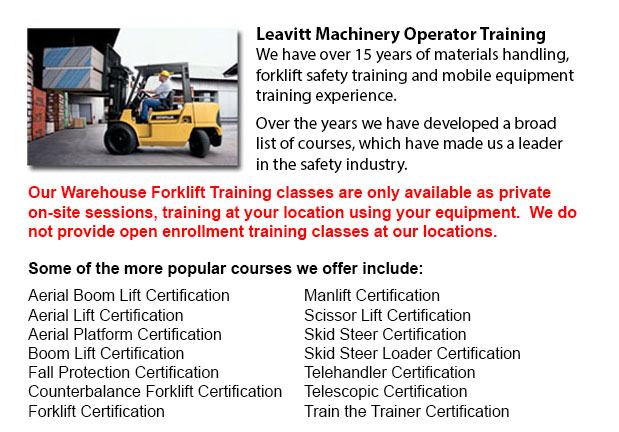
Warehouse Forklift Training Programs Kamloops - Warehouses can be commercial, retail or industrial facilities. Their function could vary from retailing bulk products to product distribution. Regardless of the kind of warehouse, personnel in warehouse settings should be well trained in safety procedures related to material handling and storage, conveyor systems, loading docks, and forklifts and pallet jacks. Good housekeeping is vital to an orderly and safe warehouse environment.
The loading dock system is normally build into the warehouse at a height from the ground making it easy to move items moving out and coming in of the warehouse. Staff will likewise unload and load materials and merchandise from the ramps and elevated docks. Particular attention must be paid to safety practice throughout this stage. To be able to avoid falls, install yellow striping along the edge of docks and ramps. Pay attention to the area all-around delivery trucks which are parked at the loading dock, specifically the part between dock and the truck. Be sure that truck wheels are chocked when unloading.
Some warehouses utilize conveyor systems to distribute products inside the facility. Conveyor systems have moving belts and wheels that pose a pinch point hazard. Keep body parts and hair well away from conveyors to avoid injury. Elevated conveyors pose a hazard to employees underneath if safety nets are absent. Employees should know how to stop conveyors in the event of emergency. Be aware of the location of off switches and emergency stop buttons. When servicing conveyors, lock out/tag out measures are mandatory.
Pallet jacks and forklifts are designed to move materials all-around the warehouse. Forklift operators are needed to take training and be given certification. Pallet jack operators do not need certification, but should be trained about the equipment. Training programs instruct operators in the proper methods for lifting materials and transporting them to their assigned location. Neither pallet jacks nor forklifts must ever be made use of to transport or lift workers.
To allow for sufficient room for machines and individuals to pass, rack systems and storage shelving help to create an efficient and orderly work space, specially if they are properly braced. Careful and slow placement of good is required to avoid accidents caused by products falling off the facing aisle. Aisles should be kept clear by storing products flat and within the shelving units. Pallets are utilized for stacking products. They must be in good condition, and palleted products should be shrink-wrapped or baled, whenever possible.
PPE or likewise referred to as personal protective equipment must be worn when required to help protect the workers' heads, limbs, hands and feet. Hard hats or bump caps, gloves and steel-toed shoes are common PPE.
Slippery floors which are pocked with dents and pits may present significant hazards, making good housekeeping really essential. Warehouse docks and floors should be clear of dirt, debris and oil. The area should be kept clear of garbage, boxes and baling supplies.
-
Forklift Training Course Kamloops
Forklift Training Course Kamloops - CSA and OSHA establish criteria for forklift safety training that meets current standards and regulations. Anybody planning to use a forklift is needed to successfully complete safety training prior to utilizing an... More -
Forklift Training Program Kamloops
Forklift Training Program Kamloops - The forklift is a common powered industrial vehicle which is in wide use these days. They are occasionally called lift trucks, jitneys or hi los. A departments store will use the forklift in order to unload and lo... More -
Aerial Lift Training Kamloops
Aerial Lift Training Kamloops - The mechanized access platform known as an aerial work platform is a machinery which provides access to places that are otherwise inaccessible to people and other machine. Likewise called an elevating work platform or... More -
Forklift Training School Kamloops
Forklift Training School Kamloops - Forklift Training School - CSA and OSHA establish criteria for forklift safety training which meets existing standards and regulations. Anybody planning to use a forklift is needed to successfully complete safety t... More -
Heavy Equipment Training Courses Kamloops
Heavy Equipment Training Courses Kamloops - When choosing a heavy equipment operator course, the initial step must be to determine the capacity in which you would be working with heavy machines. You could find the correct course to teach you how to o... More -
Heavy Equipment Training School Kamloops
Heavy Equipment Training School Kamloops - HEO or also known as the heavy equipment operator courses would provide you with the skills and knowledge required in order to enter the workforce as an entry level heavy machine operator. In this 12 week co... More -
Telehandler Operator Training Kamloops
Telehandler Operator Training Kamloops - Telescopic handler Forklifts or telehandler forklifts are common industrial equipment found in numerous construction industry environment. The telehandler is a helpful machinery and makes for a valuable tool w... More -
Telehandler License Kamloops
Telehandler License Kamloops - A telehandler or telescopic handler is a machine which is frequently utilized in agricultural and industrial applications. It has a similar appearance to a forklift and even works in a similar manner, though, the teleha... More

Forklift Training Kamloops
TOLL FREE: 1-888-254-6157
Kamloops, British Columbia
forklifttrainingkamloops.com
Email Us
About Us


